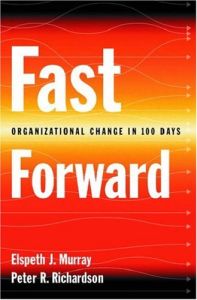Зарегистрируйтесь на getAbstract, чтобы получить доступ к этому краткому изложению.

Зарегистрируйтесь на getAbstract, чтобы получить доступ к этому краткому изложению.
Elspeth J. Murray and Peter R. Richardson
Fast Forward
Organizational Change in 100 Days
Oxford UP, 2002
Что внутри?
Do you have to manage a major organizational change? Set your countdown clock to 100 days.
Recommendation
The lessons Elspeth Murray and Peter Richardson wish to convey about organizational change are important, applicable and easy to sum up: If you want to change, do it quickly. The first 100 days are crucial. Build “speed, critical mass and intelligent momentum.” Traditional models of decision making and strategic planning take too much time and contain far too many bottlenecks, making them inappropriate for the Information Age. The authors have done their research and they clearly explain the key elements of change and how to apply them to a range of situations. In fact, the authors do too good a job of emphasizing their main points: The book’s drawback is its repetitiveness. getAbstract recommends that leaders who haven’t yet managed a major change or those who wonder why their efforts have not succeeded read this book – especially the first half. Once you understand the core concepts, you may be able to read the rest less intently.
Summary
About the Authors
Elspeth J. Murray is an associate professor at Queen’s University, where she focuses on strategic management, especially new endeavors. Peter R. Richardson is a professor at Queen’s University and the author of Cost Containment: The Ultimate Strategic Guide.



















Comment on this summary